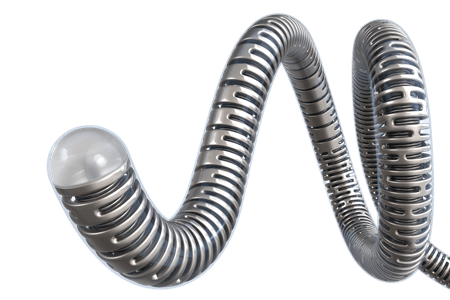A multicenter study led by an Indiana University School of Medicine neuroendovascular surgeon found that a novel device used to surgically treat patients with large vessel occlusions — a severe type of ischemic stroke — is a safe and effective way to remove blood clots in the brain.
Every 70 to 90 seconds, someone in the United States has a stroke or a mini stroke. Large vessel occlusions, which require a thrombectomy, account for 10-15% of total ischemic strokes.
Kaustubh Limaye, MD, an associate professor of clinical neurology, neurological surgery and radiology and imaging sciences at the IU School of Medicine, is a fellowship-trained neuroendovascular surgeon who regularly performs thrombectomies — a surgery that removes blood clots from inside arteries in brains of stroke patients — at IU Health Methodist Hospital.
 Limaye spearheaded the multicenter study with faculty physicians and researchers at 12 institutions across the U.S. The novel device they investigated is a Food and Drug Administration-approved macrowire, developed by Aristotle Colossus, that is used in lieu of the traditional mechanical thrombectomy. The device uses a microwire and a microcatheter to deliver an aspiration catheter by crossing the clot to perform the surgery.
Limaye spearheaded the multicenter study with faculty physicians and researchers at 12 institutions across the U.S. The novel device they investigated is a Food and Drug Administration-approved macrowire, developed by Aristotle Colossus, that is used in lieu of the traditional mechanical thrombectomy. The device uses a microwire and a microcatheter to deliver an aspiration catheter by crossing the clot to perform the surgery.
"There are multiple benefits, but key procedural benefits are that you don't have to disrupt the thrombus, and you don't have to cross the clot with the microwire, which can cause complications," Limaye said. "This study of the macrowire is the first in line with a new philosophy within the field of vascular neurology of how we can revamp the procedure of mechanical thrombectomy to make it more streamlined, safe and effective."
Limaye, who joined the Department of Neurology at the IU School of Medicine in 2021, had been involved in initial testing of the macrowire product. Once it received FDA clearance in 2023, Limaye and a group of neuroendovascular surgeons across the country decided to develop the first study to evaluate using the macrowire alone to deliver the aspiration catheter.
Called the Macrowire for Intracranial Thrombectomy (MINT) Registry, the multicenter, observational study recruited more than 125 patients at 10 high-volume hospitals over the course of a year to study the feasibility of the device. The registry collected patient clinic, demographic and imaging data, as well as the rate of success and number of complications.
According to the initial findings, surgeons were able to successfully perform the procedure using the macrowire in 92% of patients, Limaye said, resulting in a rate of complications much lower than the traditional method.
The team of researchers published their findings and the study design in "Interventional Neuroradiology" and "Stroke: Vascular and Interventional Neurology," respectfully.
"Using the traditional method, if your microwire or microcatheter crosses the clot, you are guiding yourself with your anatomical knowledge,” Limaye said. “Those cases can cause complications by perforating the small artery or cause blockages. We completely negate that using the macrowire — so there's a significant number of technical advantages."
While the initial funding for the MINT Registry was limited to one year of evaluating patients, Limaye said the registry’s investigators are studying the downstream effects of this new procedure on timing and clinical outcomes of patients in comparisons with the standard of care practice. Additionally, they plan to continue studying MINT technique for effectiveness with delivery of ultra-large bore catheters, safety and potential cost savings.
The group is also looking into how to safely conduct thrombectomies for blockages in smaller arteries that have more branches, Limaye said.
